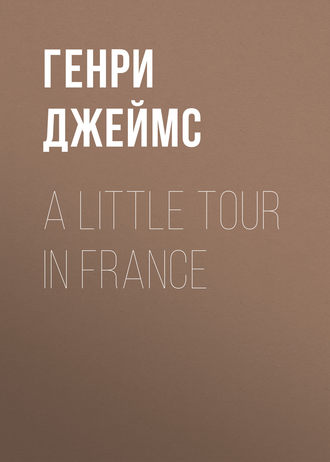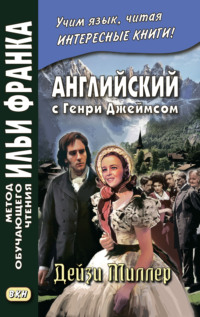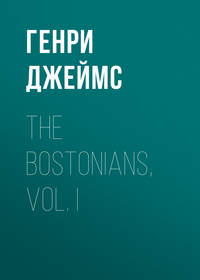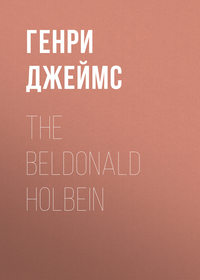 полная версия
полная версияA Little Tour in France
The view of the cathedral from the rear is, as usual, very fine. A small garden behind it masks its base; but you descend the hill to a large place de foire, ad- jacent to a fine old pubic promenade which is known as Les Jacobins, a sort of miniature Tuileries, where I strolled for a while in rectangular alleys, destitute of herbage, and received a deeper impression of vanished things. The cathedral, on the pedestal of its hill, looks considerably farther than the fair-ground and the Jacobins, between the rather bare poles of whose straightly planted trees you may admire it at a con- venient distance. I admired it till I thought I should remember it (better than the event has proved), and then I wandered away and looked at another curious old church, Notre-Dame-de-la-Couture. This sacred edifice made a picture for ten minutes, but the picture has faded now. I reconstruct a yellowish-brown facade, and a portal fretted with early sculptures; but the details have gone the way of all incomplete sensations. After you have stood awhile in the choir of the cathedral, there is no sensation at Le Mans that goes very far. For some reason not now to be traced, I had looked for more than this. I think the reason was to some extent simply in the name of the place; for names, on the whole, whether they be good reasons or not, are very active ones. Le Mans, if I am not mistaken, has a sturdy, feudal sound; suggests some- thing dark and square, a vision of old ramparts and gates. Perhaps I had been unduly impressed by the fact, accidentally revealed to me, that Henry II., first of the English Plantagenets, was born there. Of course it is easy to assure one's self in advance, but does it not often happen that one had rather not be assured? There is a pleasure sometimes in running the risk of disappointment. I took mine, such as it was, quietly enough, while I sat before dinner at the door of one of the cafes in the market-place with a bitter-et-curacao (invaluable pretext at such an hour!) to keep me com- pany. I remember that in this situation there came over me an impression which both included and ex- cluded all possible disappointments. The afternoon was warm and still; the air was admirably soft. The good Manceaux, in little groups and pairs, were seated near me; my ear was soothed by the fine shades of French enunciation, by the detached syllables of that perfect tongue. There was nothing in particular in the prospect to charm; it was an average French view. Yet I felt a charm, a kind of sympathy, a sense of the completeness of French life and of the lightness and brightness of the social air, together with a desire to arrive at friendly judgments, to express a positive interest. I know not why this transcendental mood should have descended upon me then and there; but that idle half-hour in front of the cafe, in the mild October afternoon, suffused with human sounds, is perhaps the most definite thing I brought away from Le Mans.
XIV
I am shocked at finding, just after this noble de- claration of principles that in a little note-book which at that time I carried about with me, the celebrated city of Angers is denominated a "sell." I reproduce this vulgar term with the greatest hesitation, and only because it brings me more quickly to my point. This point is that Angers belongs to the disagreeable class of old towns that have been, as the English say, "done up." Not the oldness, but the newness, of the place is what strikes the sentimental tourist to-day, as he wanders with irritation along second-rate boulevards, looking vaguely about him for absent gables. "Black Angers," in short, is a victim of modern improvements, and quite unworthy of its admirable name, – a name which, like that of Le Mans, had always had, to my eyes, a highly picturesque value. It looks particularly well on the Shakspearean page (in "King John"), where we imagine it uttered (though such would not have been the utterance of the period) with a fine old in- sular accent. Angers figures with importance in early English history: it was the capital city of the Plantagenet race, home of that Geoffrey of Anjou who married, as second husband, the Empress Maud, daughter of Henry I. and competitor of Stephen, and became father of Henry II., first of the Plantagenet kings, born, as we have seen, at Le Mans. The facts create a natural presumption that Angers will look historic; I turned them over in my mind as I travelled in the train from Le Mans, through a country that was really pretty, and looked more like the usual English than like the usual French scenery, with its fields cut up by hedges and a considerable rotundity in its trees. On my way from the station to the hotel, however, it became plain that I should lack a good pretext for passing that night at the Cheval Blanc; I foresaw that I should have con- tented myself before th e end of the day. I remained at the White Horse only long enough to discover that it was an exceptionally good provincial inn, one of the best that I encountered during six weeks spent in these establishments.
"Stupidly and vulgarly rnodernized," – that is an- other phrase from my note-book, and note-books are not obliged to be reasonable. "There are some narrow and tortuous-streets, with a few curious old houses," – I continue to quote; "there is a castle, of which the ex- terior is most extraordinary, and there is a cathedral of moderate interest. It is fair to say that the Chateau d'Angers is by itself worth a pilgrimage; the only drawback is that you have seen it in a quarter of an hour. You cannot do more than look at it, and one good look does your business. It has no beauty, no grace, no detail, nothing that charms or detains you; it is simply very old and very big, – so big and so old that this simple impression is enough, and it takes its place in your recollections as a perfect specimen of a superannuated stronghold. It stands at one end of the town, surrounded by a huge, deep moat, which originally contained the waters of the Maine, now divided from it by a quay. The water-front of Angers is poor, – wanting in color and in movement; and there is always an effect of perversity in a town lying near a great river and, yet not upon it. The Loire is a few miles off; but Angers contents itself with a meagre affluent of that stream. The effect was naturally much better when the huge, dark mass of the castle, with its seventeen prodigious towers, rose out of the protecting flood. These towers are of tremendous girth and soli- dity; they are encircled with great bands, or hoops, of white stone, and are much enlarged at the base. Between them hang vast curtains of infinitely old-look- ing masonry, apparently a dense conglomeration of slate, the material of which the town was originally built (thanks to rich quarries in the neighborhood), and to which it owed its appellation of the Black. There are no windows, no apertures, and to-day no battlements nor roofs. These accessories were removed by Henry III., so that, in spite of its grimness and blackness, the place has not even the interest of look- ing like a prison; it being, as I supposed, the essence of a prison not to be open to the sky. The only features of the enormous structure are the black, sombre stretches and protrusions of wall, the effect of which, on so large a scale, is strange and striking. Begun by Philip Augustus, and terminated by St. Louis, the Chateau d'Angers has of course a great deal of history. The luckless Fouquet, the extravagant minister of finance of Louis XIV., whose fall from the heights of grandeur was so sudden and complete, was confined here in 1661, just after his arrest, which had taken place at Nantes. Here, also, Huguenots and Vendeans have suffered effective captivity.
I walked round the parapet which protects the outer edge of the moat (it is all up hill, and the moat deepens and deepens), till I came to the entrance which faces the town, and which is as bare and strong as the rest. The concierge took me into the court; but there was nothing to see. The place is used as a magazine of ammunition, and the yard con- tains a multitude of ugly buildings. The only thing to do is to walk round the bastions for the view; but at the moment of my visit the weather was thick, and the bastions began and ended with themselves. So I came out and took another look at the big, black ex- terior, buttressed with white-ribbed towers, and per- ceived that a desperate sketcher might extract a picture from it, especially if he were to bring in, as they say, the little black bronze statue of the good King Rene (a weak production of David d'Angers), which, standing within sight, ornaments the melancholy faubourg. He would do much better, however, with the very striking old timbered house (I suppose of the fifteenth century) which is called the Maison d'Adam, and is easily the first specimen at Angers of the domestic architecture of the past. This admirable house, in the centre of the town, gabled, elaborately timbered, and much restored, is a really imposing monument. The basement is occupied by a linen- draper, who flourishes under the auspicious sign of the Mere de Famille; and above his shop the tall front rises in five overhanging stories. As the house occupies the angle of a little place, this front is double, and the black beams and wooden supports, displayed over a large surface and carved and interlaced, have a high picturesqueness. The Maison d'Adam is quite in the grand style, and I am sorry to say I failed to learn what history attaches to its name. If I spoke just above of the cathedral as "moderate," I suppose I should beg its pardon; for this serious charge was probably prompted by the fact that it consists only of a nave, without side aisles. A little reflection now convinces me that such a form is a distinction; and, indeed, I find it mentioned, rather inconsistently, in my note-book, a little further on, as "extremely simple and grand." The nave is spoken of in the same volume as "big, serious, and Gothic," though the choir and transepts are noted as very shallow. But it is not denied that the air of the whole thing is original and striking; and it would therefore appear, after all, that the cathedral of Angers, built during the twelfth and thirteenth centuries, is a sufficiently honorable church; the more that its high west front, adorned with a very primitive Gothic portal, supports two elegant tapering spires, between which, unfortunately, an ugly modern pavilion has been inserted.
I remember nothing else at Angers but the curious old Cafe Serin, where, after I had had my dinner at the inn, I went and waited for the train which, at nine o'clock in the evening, was to convey me, in a couple of hours, to Nantes, – an establishment remarkable for its great size and its air of tarnished splendor, its brown gilding and smoky frescos, as also for the fact that it was hidden away on the second floor of an un- assuming house in an unilluminated street. It hardly seemed a place where you would drop in; but when once you had found it, it presented itself, with the cathedral, the castle, and the Maison d'Adam, as one of the historical monuments of Angers.
XV
If I spent two nights at Nantes, it was for reasons of convenience rather than of sentiment; though, in- deed, I spent them in a big circular room which had a stately, lofty, last-century look, – a look that con- soled me a little for the whole place being dirty. The high, old-fashioned, inn (it had a huge, windy porte- cochere, and you climbed a vast black stone staircase to get to your room) looked out on a dull square, sur- rounded with other tall houses, and occupied on one side by the theatre, a pompous building, decorated with columns and statues of the muses. Nantes be- longs to the class of towns which are always spoken of as "fine," and its position near the mouth of the Loire gives it, I believe, much commercial movement. It is a spacious, rather regular city, looking, in the parts that I traversed, neither very fresh nor very venerable. It derives its principal character from the handsome quays on the Loire, which are overhung with tall eighteenth-century houses (very numerous, too, in the other streets), – houses, with big entresols marked by arched windows, classic pediments, balcony- rails of fine old iron-work. These features exist in still better form at Bordeaux; but, putting Bordeaux aside, Nantes is quite architectural. The view up and down the quays has the cool, neutral tone of color that one finds so often in French water-side places, – the bright grayness which is the tone of French land- scape art. The whole city has rather a grand, or at least an eminently well-established air. During a day passed in it of course I had time to go to the Musee; the more so that I have a weakness for provincial museums, – a sentiment that depends but little on the quality of the collection. The pictures may be bad, but the place is often curious; and, indeed, from bad pictures, in certain moods of the mind, there is a degree of entertainment to be derived. If they are tolerably old they are often touching; but they must have a relative antiquity, for I confess I can do no- thing with works of art of which the badness is of receat origin. The cool, still, empty chambers in which indifferent collections are apt to be preserved, the red brick tiles, the diffused light, the musty odor, the mementos around you of dead fashions, the snuffy custodian in a black skull cap, who pulls aside a faded curtain to show you the lustreless gem of the museum, – these things have a mild historical quality, and the sallow canvases after all illustrate something. Many of those in the museum of Nantes illustrate the taste of a successful warrior; having been bequeathed to the city by Napoleon's marshal, Clarke (created Duc de Feltre). In addition to these there is the usual number of specimens of the contemporary French school, culled from the annual Salons and presented to the museum by the State. Wherever the traveller goes, in France, he is reminded of this very honorable practice, – the purchase by the Government of a cer- tain number of "pictures of the year," which are pre- sently distributed in the provinces. Governments suc- ceed each other and bid for success by different devices; but the "patronage of art" is a plank, as we should say here, in every platform. The works of art are often ill-selected, – there is an official taste which you immediately recognize, – but the custom is essen- tially liberal, and a government which should neglect it would be felt to be painfully common. The only thing in this particular Musee that I remember is a fine portrait of a woman, by Ingres, – very flat and Chinese, but with an interest of line and a great deal of style.
There is a castle at Nantes which resembles in some degree that of Angers, but has, without, much less of the impressiveness of great size, and, within, much more interest of detail. The court contains the remains of a very fine piece of late Gothic, a tall ele- gant building of the sixteenth century. The chateau is naturally not wanting in history. It was the residence of the old Dukes of Brittany, and was brought, with the rest of the province, by the Duchess Anne, the last representative of that race, as her dowry, to Charles VIII. I read in the excellent hand-book of M. Joanne that it has been visited by almost every one of the kings of France, from Louis XI. downward; and also that it has served as a place of sojourn less voluntary on the part of various other distinguished persons, from the horrible Merechal de Retz, who in the fifteenth century was executed at Nantes for the murder of a couple of hundred young children, sacrificed in abomin- able rites, to the ardent Duchess of Berry, mother of the Count of Chambord, who was confined there for a few hours in 1832, just after her arrest in a neigh- boring house. I looked at the house in question – you may see it from the platform in front of the chateau – and tried to figure to myself that embarrassing scene. The duchess, after having unsuccessfully raised the standard of revolt (for the exiled Bourbons), in the legitimist Bretagne, and being "wanted," as the phrase is, by the police of Louis Philippe, had hidden herself in a small but loyal house at Nantes, where, at the end of five months of seclusion, she was betrayed, for gold, to the austere M. Guizot, by one of her servants, an Alsatian Jew named Deutz. For many hours before her capture she had been compressed into an inter- stice behind a fireplace, and by the time she was drawn forth into the light she had been ominously scorched. The man who showed me the castle in- dicated also another historic spot, a house with little tourelles, on the Quai de la Fosse, in which Henry IV. is said to have signed the Edict of Nantes. I am, however, not in a position to answer for this pedigree.
There is another point in the history of the fine old houses which command the Loire, of which, I sup- pose, one may be tolerably sure; that is, their having, placid as they stand there to-day, looked down on the horrors of the Terror of 1793, the bloody reign of the monster Carrier and his infamous noyades. The most hideous episode of the Revolution was enacted at Nantes, where hundreds of men and women, tied to- gether in couples, were set afloat upon rafts and sunk to the bottom of the Loire. The tall eighteenth-century house, full of the air noble, in France always reminds me of those dreadful years, – of the street-scenes of the Revolution. Superficially, the association is incongru- ous, for nothing could be more formal and decorous than the patent expression of these eligible residences. But whenever I have a vision of prisoners bound on tumbrels that jolt slowly to the scaffold, of heads car- ried on pikes, of groups of heated citoyennes shaking their fists at closed coach-windows, I see in the back- ground the well-ordered features of the architecture of the period, – the clear gray stone, the high pilasters, the arching lines of the entresol, the classic pediment, the slate-covered attic. There is not much architecture at Nantes except the domestic. The cathedral, with a rough west front and stunted towers, makes no im- pression as you approach it. It is true that it does its best to recover its reputation as soon as you have passed the threshold. Begun in 1434 and finished about the end of the fifteenth century, as I discover in Murray, it has a magnificent nave, not of great length, but of extraordinary height and lightness. On the other hand, it has no choir whatever. There is much entertainment in France in seeing what a cathedral will take upon itself to possess or to lack; for it is only the smaller number that have the full complement of features. Some have a very fine nave and no choir; others a very fine choir and no nave. Some have a rich outside and nothing within; others a very blank face and a very glowing heart. There are a hundred possibilities of poverty and wealth, and they make the most unexpected combinations.
The great treasure of Nantes is the two noble se- pulchral monuments which occupy either transept, and one of which has (in its nobleness) the rare distinction of being a production of our own time. On the south side stands the tomb of Francis II., the last of the Dukes of Brittany, and of his second wife, Margaret of Foix, erected in 1507 by their daughter Anne, whom we have encountered already at the Chateau de Nantes, where she was born; at Langeais, where she married her first husband; at Amboise, where she lost him; at Blois, where she married her second, the "good" Louis XII., who divorced an impeccable spouse to make room for her, and where she herself died. Trans- ferred to the cathedral from a demolished convent, this monument, the masterpiece of Michel Colomb, author of the charming tomb of the children of Charles VIII. and the aforesaid Anne, which we admired at Saint Gatien of Tours, is one of the most brilliant works of the French Renaissance. It has a splendid effect, and is in perfect preservation. A great table of black marble supports the reclining figures of the duke and duchess, who lie there peacefully and majestically, in their robes and crowns, with their heads each on a cushion, the pair of which are supported, from behind, by three, charming little kneeling angels; at the foot of the quiet couple are a lion and a greyhound, with heraldic devices. At each of the angles of the table is a large figure in white marble of a woman elaborately dressed, with a symbolic meaning, and these figures, with their contemporary faces and clothes, which give them the air of realistic portraits, are truthful and liv- ing, if not remarkably beautiful. Round the sides of the tomb are small images of the apostles. There is a kind of masculine completeness in the work, and a certain robustness of taste.
In nothing were the sculptors of the Renaissance more fortunate than in being in advance of us with their tombs: they have left us noting to say in regard to the great final contrast, – the contrast between the immobility of death and the trappings and honors that survive. They expressed in every way in which it was possible to express it the solemnity, of their conviction that the Marble image was a part of the personal greatness of the defunct, and the protection, the re- demption, of his memory. A modern tomb, in com- parison, is a sceptical affair; it insists too little on the honors. I say this in the face of the fact that one has only to step across the cathedral of Nantes to stand in the presence of one of the purest and most touching of modern tombs. Catholic Brittany has erected in the opposite transept a monument to one of the most devoted of her sons, General de Lamoriciere, the de- fender of the Pope, the vanquished of Castelfidardo. This noble work, from the hand of Paul Dubois, one of the most interesting of that new generation of sculp- tors who have revived in France an art of which our overdressed century had begun to despair, has every merit but the absence of a certain prime feeling. It is the echo of an earlier tune, – an echo with a beauti- ful cadence. Under a Renaissance canopy of white marble, elaborately worked with arabesques and che- rubs, in a relief so low that it gives the work a cer- tain look of being softened and worn by time, lies the body of the Breton soldier, with, a crucifix clasped to his breast and a shroud thrown over his body. At each of the angles sits a figure in bronze, the two best of which, representing Charity and Military Courage, had given me extraordinary pleasure when they were exhibited (in the clay) in the Salon of 1876. They are admirably cast, and they have a certain greatness: the one, a serene, robust young mother, beautiful in line and attitude; the other, a lean and vigilant young man, in a helmet that overshadows his serious eyes, resting an outstretched arm, an admirable military member, upon the hilt of a sword. These figures con- tain abundant assurance that M. Paul Dubois has been attentive to Michael Angelo, whom we have all heard called a splendid example but a bad model. The visor-shadowed face of his warrior is more or less a reminiscence of the figure on the tomb of Lorenzo de' Medici at Florence; but it is doubtless none the worse for that. The interest of the work of Paul Dubois is its peculiar seriousness, a kind of moral good faith which is not the commonest feature of French art, and which, united as it is in this case with exceeding knowledge and a remarkable sense of form, produces an impression, of deep refinement. The whole monu- ment is a proof of exquisitely careful study; but I am not sure that this impression on the part of the spec- tator is altogether a happy one. It explains much of its great beauty, and it also explains, perhaps, a little of a certain weakness. That word, however, is scarcely in place; I only mean that M. Dubois has made a vi- sible effort, which has been most fruitful. Simplicity is not always strength, and our complicated modern genius contains treasures of intention. This fathomless modern element is an immense charm on the part of M. Paul Dubois. I am lost in admiration of the deep aesthetic experience, the enlightenment of taste, re- vealed by such work. After that, I only hope that Giuseppe Garibaldi may have a monument as fair.
XVI
To go from Nantes to La Rochelle you travel straight southward, across the historic bocage of La Vendee, the home of royalist bush-fighting. The country, which is exceedingly pretty, bristles with copses, orchards, hedges, and with trees more spread- ing and sturdy than the traveller is apt to deem the feathery foliage of France. It is true that as I pro- ceeded it flattened out a good deal, so that for an hour there was a vast featureless plain, which offered me little entertainment beyond the general impression that I was approaching the Bay of Biscay (from which, in reality, I was yet far distant). As we drew near La Rochelle, however, the prospect brightened con- siderably, and the railway kept its course beside a charming little canal, or canalized river, bordered with trees, and with small, neat, bright-colored, and yet old-fashioned cottages and villas, which stood back on the further side, behind small gardens, hedges, painted palings, patches of turf. The whole effect was Dutch and delightful; and in being delightful, though not in being Dutch, it prepared me for the charms of La Rochelle, which from the moment I entered it I perceived to be a fascinating little town, a most original mixture of brightness and dulness. Part of its brightness comes from its being extra- ordinarily clean, – in which, after all, it is Dutch; a virtue not particularly noticeable at Bourges, Le Mans, and Angers. Whenever I go southward, if it be only twenty miles, I begin to look out for the south, pre- pared as I am to find the careless grace of those lati- tudes even in things of which it may, be said that they may be south of something, but are not southern. To go from Boston to New York (in this state of mind) is almost as soft a sensation as descending the Italian side, of the Alps; and to go from New York to Philadelphia is to enter a zone of tropical luxuriance and warmth. Given this absurd disposition, I could not fail to flatter myself, on reaching La Rochelle, that I was already in the Midi, and to perceive in everything, in the language of the country, the ca- ractere meridional. Really, a great many things had a hint of it. For that matter, it seems to me that to arrive in the south at a bound – to wake up there, as it were – would be a very imperfect pleasure. The full pleasure is to approach by stages and gradations; to observe the successive shades of difference by which it ceases to be the north. These shades are exceedingly fine, but your true south-lover has an eye for them all. If he perceive them at New York and Philadelphia, – we imagine him boldly as liberated from Boston, – how could he fail to perceive them at La Rochelle? The streets of this dear little city are lined with arcades, – good, big, straddling arcades of stone, such as befit a land of hot summers, and which recalled to me, not to go further, the dusky portions of Bayonne. It contains, moreover, a great wide place d'armes, which looked for all the world like the piazza of some dead Italian town, empty, sunny, grass-grown, with a row of yellow houses overhanging it, an unfrequented cafe, with a striped awning, a tall, cold, florid, uninteresting cathedral of the eighteenth century on one side, and on the other a shady walk, which forms part of an old rampart. I followed this walk for some time, under the stunted trees, beside the grass-covered bastions; it is very charming, wind- ing and wandering, always with trees. Beneath the rampart is a tidal river, and on the other side, for a long distance, the mossy walls of the immense garden of a seminary. Three hundred years ago, La Rochelle was the great French stronghold of Protestantism; but to-day it appears to be a'nursery of Papists.









